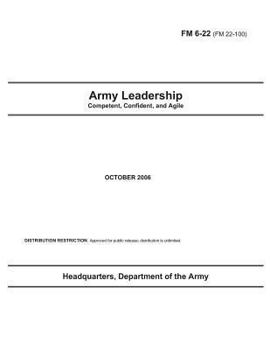Field Manual FM 6-22 (FM 22-100) Army Leadership October 2006: Competent, Confident, and Agile
As the keystone leadership manual for the United States Army, FM 6-22 establishes leadership doctrine, the fundamental principles by which Army leaders act to accomplish their mission and care for their people. FM 6-22 applies to officers, warrant officers, noncommissioned officers, and enlisted Soldiers of all Army components, and to Army civilians. From Soldiers in basic training to newly commissioned officers, new leaders learn how to lead with this manual as a basis. FM 6-22 is prepared under the direction of the Army Chief of Staff. It defines leadership, leadership roles and requirements, and how to develop leadership within the Army. It outlines the levels of leadership as direct, organizational, and strategic, and describes how to lead successfully at each level. It establishes and describes the core leader competencies that facilitate focused feedback, education, training, and development across all leadership levels. It reiterates the Army Values. FM 6-22 defines how the Warrior Ethos is an integral part of every Soldier's life. It incorporates the leadership qualities of self-awareness and adaptability and describes their critical impact on acquiring additional knowledge and improving in the core leader competencies while operating in constantly changing operational environments. In line with evolving Army doctrine, FM 6-22 directly supports the Army's capstone manuals, FM 1 and FM 3-0, as well as keystone manuals such as FM 5-0, FM 6-0, and FM 7-0. FM 6-22 connects Army doctrine to joint doctrine as expressed in the relevant joint doctrinal publications, JP 1 and JP 3-0. As outlined in FM 1, the Army uses the shorthand expression of BE-KNOW-DO to concentrate on key factors of leadership. What leaders DO emerges from who they are (BE) and what they KNOW. Leaders are prepared throughout their lifetimes with respect to BE-KNOW-DO so they will be able to act at a moment's notice and provide leadership for whatever challenge they may face. FM 6-22 expands on the principles in FM 1 and describes the character attributes and core competencies required of contemporary leaders. Character is based on the attributes central to a leader's make-up, and competence comes from how character combines with knowledge, skills, and behaviors to result in leadership. Inextricably linked to the inherent qualities of the Army leader, the concept of BE-KNOW-DO represents specified elements of character, knowledge, and behavior described here in FM 6-22.
Format:Paperback
Language:English
ISBN:1468179810
ISBN13:9781468179811
Release Date:October 2006
Publisher:Createspace Independent Publishing Platform
Length:218 Pages
Weight:1.15 lbs.
Dimensions:0.5" x 8.5" x 11.0"
Customer Reviews
1 rating
Something practical we can all use throughout our life.
Published by bernie4444 , 3 months ago
US Army Leadership Field Manual (FM 22-100)
This book carried me through two different decades in the military. It is one of the few books that make clear what leadership is and the actual mechanics of leadership, which can apply to everyday life.
But for anyone in the military or planning a military career, this book is worth reading, even if not issued.
I plan to use it if I ever get around to authoring that novel.
This book is much more than the sum of its parts, and to understand it, you must live it.
One of my favorites is:
“The practical value of history is to throw the film of the past through the material projector of the present onto the screen of the future.” - B. H. Liddell Hart (1895-1970), English Military Writer and Strategist.





